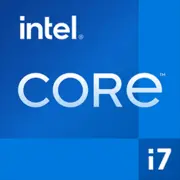Intel Core i7-12700T

Intel Core i7-12700T: Potenza Ibrida per Sistemi Energoefficienti
Marzo 2025
Introduzione
I processori della serie Intel di 12a generazione (Alder Lake) sono diventati rivoluzionari grazie all'architettura ibrida che unisce core ad alte prestazioni e core ad alta efficienza energetica. L’Intel Core i7-12700T è uno dei rappresentanti più interessanti di questa linea, combinando 12 core, un TDP di 35 W e supporto per DDR5. Nel 2025, questo chip rimane rilevante per PC compatti, sistemi da ufficio e workstation. Analizziamo a chi è adatto l’i7-12700T e come utilizzarlo correttamente.
1. Caratteristiche principali: Architettura Alder Lake e caratteristiche chiave
Architettura ibrida e processo tecnologico
Il processore è costruito sull'architettura ibrida Alder Lake, dove 8 Performance-cores (P-cores) si occupano dei task pesanti, mentre 4 Efficient-cores (E-cores) gestiscono i processi in background. I P-core funzionano con Hyper-Threading (16 thread), gli E-core — senza (4 thread), per un totale di 12 core e 20 thread.
Processo tecnologico Intel 7 (10 nm Enhanced SuperFin) offre un equilibrio tra efficienza energetica e prestazioni. La frequenza di base dei P-core è di 1.4 GHz, ma in modalità turbo raggiunge i 4.6 GHz. Questo è ideale per sistemi con raffreddamento passivo o compatto.
Cache e grafica: 25 MB di cache L3 accelerano i task multithreaded, mentre l’Intel UHD Graphics 770 (frequenza di base 300 MHz, dinamica — 1.5 GHz) gestisce video 4K e giochi poco esigenti.
Prestazioni
- Geekbench 6: 2254 (single-core), 9882 (multi-core).
- Cinebench R23: ~1800 (Single Core), ~17000 (Multi Core).
A titolo di confronto: nelle attività multithreaded, l’i7-12700T è vicino al Ryzen 7 7700X, ma consuma la metà dell'energia.
2. Schede madri compatibili: Socket LGA 1700 e chipset
Socket e chipset
Il processore utilizza il socket LGA 1700, compatibile con i seguenti chipset:
- H610: Opzione budget per PC da ufficio. Nessun overclock, supporto limitato per PCIe 4.0. Esempio: ASUS Prime H610M-E ($120).
- B660: Scelta ottimale. Supporto per DDR4/DDR5, PCIe 4.0. Esempio: MSI PRO B660M-A WiFi ($150).
- Z690/Z790: Per gli appassionati. Overclock della memoria, più porte. Esempio: Gigabyte Z790 UD AC ($220).
Caratteristiche della scelta:
- Per l’i7-12700T non è necessario un chipset di alto livello — anche l’H610 è sufficiente grazie al basso TDP.
- Se è necessaria la DDR5, scegliete schede che supportano XMP 3.0.
3. Memoria supportata: DDR4 vs DDR5
Il processore supporta DDR4-3200 e DDR5-4800. Nel 2025 la DDR5 è diventata più accessibile, ma la DDR4 è ancora vantaggiosa:
- DDR4-3200 32 GB: $80–100.
- DDR5-4800 32 GB: $130–160.
Raccomandazioni:
- Per compiti d’ufficio e media center — DDR4.
- Per workstation (rendering, codifica) — DDR5 con latenze basse.
4. Alimentatori: Calcolo della potenza
Con un TDP di 35 W, il processore influisce modestamente sul consumo energetico, ma il sistema in generale richiede:
- Senza grafica discreta: PSU 300–400 W (ad esempio, be quiet! Pure Power 11 400W, $60).
- Con scheda video (NVIDIA RTX 4060 o simili): PSU 550–650 W (Corsair RM650x, $100).
Importante: Anche gli alimentatori potenti non devono essere di bassa qualità — rischio per la stabilità del sistema.
5. Pro e contro dell’Intel Core i7-12700T
Pro:
- Efficienza energetica: Ideale per mini-PC e sistemi con raffreddamento passivo.
- Multithreading: 20 thread gestiscono rendering e virtualizzazione.
- Grafica integrata: Esegue CS:GO a 60 FPS (1080p, impostazioni basse).
Contro:
- Bassa frequenza di base: In compiti intensivi senza boost turbo possono verificarsi ritardi.
- Nessun overclock: La versione senza suffisso «K» non supporta l'overclocking.
- Prezzo: Nel 2025, il chip costa $320–350, più caro del Ryzen 7 7700 ($300).
6. Scenari di utilizzo
Ufficio e multimedia
- Esempio: Configurazione basata su ASUS Prime H610M-E, 16 GB DDR4, SSD 1 TB. Consumo — 50 W in idle, rumore — 22 dB. Adatto per lavorare con documenti e video 4K.
Gaming
- Esempio: Con RTX 4060 e DDR5-4800, il processore offre 100+ FPS in Fortnite (1080p, Epic). Ma in giochi CPU-intensive (Cyberpunk 2077) possono verificarsi flessioni a causa della frequenza di base.
Attività lavorative
- Virtualizzazione (VMware), rendering 3D (Blender), codifica video (HandBrake) — grazie ai 20 thread.
7. Confronto con i concorrenti
AMD Ryzen 7 7700
- Pro di AMD: Maggiore IPC, supporto per PCIe 5.0, prezzo $300.
- Contro: 8 core contro 12, TDP 65 W.
Conclusione: Per i giochi, il Ryzen 7 7700 è migliore, per compiti multithreaded — l’i7-12700T.
Apple M2 (in mini-PC)
- Pro di Apple: Efficienza energetica, integrazione con macOS.
- Contro: Compatibilità software limitata, prezzo a partire da $600.
8. Suggerimenti per la costruzione
1. Raffreddamento: Anche il dissipatore di serie è sufficiente, ma per un funzionamento silenzioso prendi un Noctua NH-L9i ($50).
2. Case: Mini-ITX (Cooler Master NR200) o Micro-ATX compatto.
3. Storage: Assicurati di utilizzare un SSD NVMe (ad esempio, Samsung 980 Pro 1 TB, $120).
9. Conclusione finale: A chi è adatto l’i7-12700T?
Questo processore è consigliato se:
- È necessaria una sistema silenzioso ed efficiente (ufficio, server domestico).
- Serve prestazioni multithreaded per attività lavorative.
- Si prevede di utilizzarlo in un case compatto.
Pubblico target:
- Professionisti IT che lavorano con la virtualizzazione.
- Appassionati che assemblano media center.
- Impiegati d'ufficio che apprezzano la silenziosità.
Nel 2025, l’Intel Core i7-12700T rimane una scelta vantaggiosa per chi non ha bisogno del massimo delle frequenze, ma cerca un equilibrio tra potenza e consumo energetico.
Di base
Specifiche della CPU
Specifiche della memoria
Specifiche della GPU
Varie
Classifiche
Rispetto ad altre CPU
Condividi sui social media
Oppure linkaci
<a href="https://cputronic.com/it/cpu/intel-core-i7-12700t" target="_blank">Intel Core i7-12700T</a>